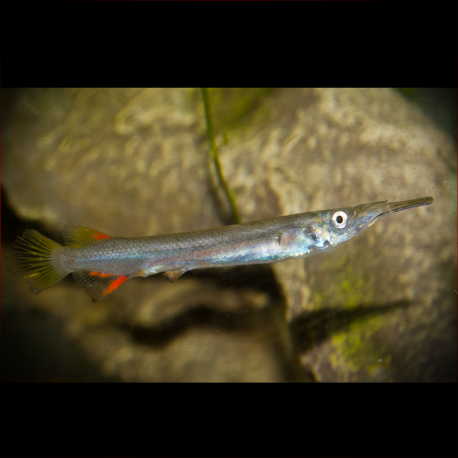More info
Datasheet
| Minimum Tank Size | 71 litres / 18.76 US gallons |
| Maximum Size | 7.0cm / 2.76inches |
| Temperature | 24°C / 75.20°F - 28°C / 82.40°F |
| Hardness | 10-20ºdH |
| pH | 6.5-8.0 |
General Description
The Wrestling Halfbeak, scientifically known as Dermogenys Pusilla, earns its common name from the elongated lower jaw that is a characteristic feature of all species within its genus. Males of this species have a tendency to fight, displaying a behavior that aligns with its moniker. In some native regions, these fish are used for fighting, with males locking jaws in battles. It is a delicate yet captivating species commonly found in the aquarium trade, making for an intriguing addition to peaceful tanks.
Aquarium Setup
The Wrestling Halfbeak, with a recommended tank size of at least 71 litres, thrives best in setups that prioritize surface area over depth. Known for spending a majority of its time just under the water surface, this species benefits from a tank with dense planting around the edges to prevent damage to its delicate mouthparts. Adding floating vegetation and a secure cover is advisable due to its jumping tendencies. The species can adapt to freshwater conditions, but the addition of salt up to a specific gravity of around 1.005 is tolerated. Water parameters should ideally be maintained with a hardness of 10-20°dH, a pH range of 6.5-8.0, and a temperature set between 24-28°C.
Behaviour
The Wrestling Halfbeak can coexist with peaceful species of similar size that share its water requirements. When kept in groups, these fish exhibit less skittish behavior. Although males may engage in sparring, lasting physical harm rarely occurs unless space is constrained. It is suggested to keep a single male or multiple males to disperse aggression effectively. Being a surface-dwelling species, it is advised to offer ample space and suitable tank mates to ensure comfort and reduced stress levels.
Feeding and Diet
Feeding exclusively from the water's surface, the Wrestling Halfbeak consumes gut-loaded Drosophila fruit flies as an ideal food source. While initially showing reluctance towards dry foods, it can be gradually accustomed to them. Additionally, the species readily accepts brine shrimp, bloodworms, and other supplementary food sources over time. Providing a high-quality varied diet is crucial to the overall health and well-being of these fish.
Reproduction & Dimorphism
Breeding the Wrestling Halfbeak can be challenging as many females tend to give birth to still-born fry, often due to nutritional deficiencies. To encourage successful breeding, setting up a species-specific tank with ample surface vegetation is recommended. Gestation periods range from 3-6 weeks, with fry typically numbering between 10-20, necessitating their removal to prevent predation by adult fish. Males exhibit sexual dimorphism through the presence of an andropodium, a genital-type organ, and a distinct red patch on the dorsal fin absent in females.
Habitat and Distribution
In its natural habitat, the Wrestling Halfbeak is commonly found in various slow-flowing or stagnant water bodies, including rivers, lakes, ponds, and flooded fields. These fish often inhabit environments rich in surface vegetation, with occasional sightings in semi-brackish conditions near mangrove swamps during seasonal changes. Distributed across regions such as India, Myanmar, Thailand, Indonesia, and the Philippines, the species thrives in diverse aquatic ecosystems throughout Southeast Asia.

